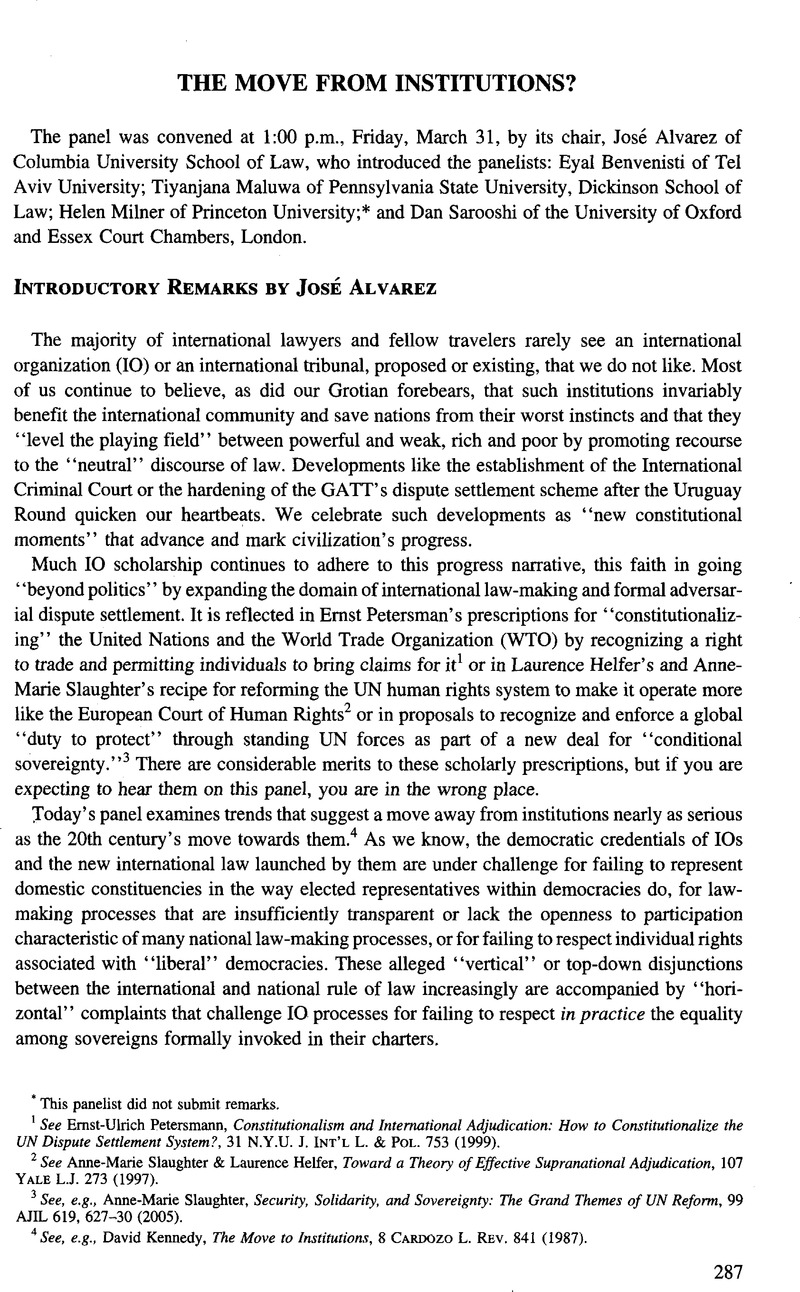No CrossRef data available.
Article contents
Introductory Remarks by José Alvarez
Published online by Cambridge University Press: 28 February 2017
Abstract

- Type
- The Move from Institutions?
- Information
- Copyright
- Copyright © American Society of International Law 2006
References
* This panelist did not submit remarks.
1 See Petersmann, Ernst-Ulrich, Constitutionalism and International Adjudication: How to Constitutionalize the UN Dispute Settlement System?, 31 N.Y.U. J. Int’l L. & Pol. 753 (1999)Google Scholar.
2 See Slaughter, Anne-Marie & Heifer, Laurence, Toward a Theory of Effective Supranational Adjudication, 107 Yale L. J. 273 (1997)Google Scholar.
3 See, e.g., Slaughter, Anne-Marie, Security, Solidarity, and Sovereignty: The Grand Themes of UN Reform, 99 AJIL 619, 627-30 (2005)CrossRefGoogle Scholar.
4 See, e.g., Kennedy, David, The Move to Institutions, 8 Cardozo L. Rev. 841 (1987)Google Scholar.
5 See, e.g., Stein, Eric, International Integration and Democracy: No Love at First Sight, 95 AJIL 489 (2001)CrossRefGoogle Scholar.
6 See, e.g., Alvarez, José E., Hegemonic International Law Revisited, 97 AJIL 873 (2003)CrossRefGoogle Scholar; Krisch, Nico, International Law in Times of Hegemony: Unequal Power and the Shaping of the International Legal Order, 16 Eur. J. Int’l L. 369 (2005)CrossRefGoogle Scholar; Lloyd Gruber, Ruling the World (2000).
7 See Hilary Charlesworth and Christine Chinkin, The Boundaries of International Law 171— 200 (2000).
8 Compare Lauterpacht, Hersch, The Grotian Tradition in International Law, 1946 Brit. Y. B. Int’l L. 1 (1946)Google Scholar (distilling the essential elements of this tradition).
9 See, e.g., Stephan, Paul, Accountability and International Lawmaking: Rules, Rents, and Legitimacy, 17 Nw. J. Int’l L. & Bus. 681 (1996-1997)Google Scholar.
10 See, e.g., Shaffer, Gregory, Power, Governance, and the WTO: A Comparative Institutional Approach, in Power in Global Governance 130 (Barnett, Michael and Duvall, Raymond eds., 2005)Google Scholar.
11 See, e.g., Deborah Z. Cass, The Constitutionalization of the World Trade Organization 207-37 (2005).
12 See, e.g., Fidler, David F. A Kindler, Gentler System of Capitulations? International Law, Structural Adjustment Policies and the Standards of Liberal, Globalized Civilization, 35 Tex.Int’l L. J. 387 (2000)Google Scholar.
13 Compare Abbott, Kenneth W. & Snidai, Duncan, Why States Act Through Formal International Organizations, 42 J. Conflict Resolution 3 (1998)CrossRefGoogle Scholar (discussing the centralization and independence benefits of IOs).
14 For a fuller explication of these themes, see Alvarez, José E., International Organizations: Then and Now, 100 AJIL 324 (2006)CrossRefGoogle Scholar.


